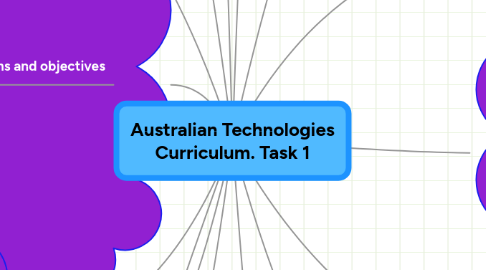
1. curriculum aims and objectives
1.1. Design and Technologies
1.1.1. Aid students in understanding the variety of roles and responsibilities of people with occupations of design and technologies occupations.
1.1.2. The aim is to develop students understanding, awareness and knowledge on a range of technology materials. Teaching them how they work and how to use them and create them. Students will learn skills needed to (both individually and cooperatively) select and manipulate a range of materials, systems, components, tools and equipment creatively, competently and safely; and managing processes in order to produce and designs solutions suitable for a range of technologies.
1.2. Digital Technologies
1.2.1. To give students the knowledge, understanding, ability and skills required to (both independently and cooperatively use computational thinking, and understand the key concepts of abstractions; data collection, representation and interpretation; specification, algorithms and implementations to allow them to be confident in using digital systems to transform a range of data into information and to creatively communicate ideas.
1.2.2. Students are able to use computational thinking and the key concepts of abstraction ; data collection, representation and interpretation; specification, algorithms and implementation to create digital solutions.
2. content descriptions
2.1. Each year / band level has content descriptors connected to them. These content descriptors highlight the knowledge, understanding and skills that students of that band/year level are required and expected to be taught and expected to learn. The content descriptors are ordered; following the developmental learning sequence..
2.2. Content descriptors are written to also ensure that learning is appropriately order (within the developmental learning sequence) to ensure that there is no unnecessary repetition in learning.
3. content elaboration
3.1. They are provided for each band / year level.
3.2. They delve deeper into the content descriptions and provide examples of how each can be taught.
3.3. They are not intended to be content points that all students must learn, but give chose as to what to teach students and how to teach students.
4. year / band levels
4.1. Foundation to year 2
4.2. Years 3 and 4
4.3. Years 5 and 6
4.4. Years 7 and 8
4.5. Years 9 and 10
5. achievement standards
5.1. These standards are to explain what students should be able to demonstrate throughout each band/year level.
5.2. Aids teachers in clearly knowing what quality of learning students must be given. And where a students knowledge should lay at each aspect of their schooling.
5.3. Achievement standards are demonstrate through students work and assessments. Work samples , portfolios, annotations of students work can all aid the teacher in assessing whether a student has met the achievement standard.
6. Learning Areas
6.1. Mathematics
6.2. English
6.3. Science
6.4. Humanities and Social Science
6.5. The Arts
6.6. Health and Physical Education
7. Key Ideas
7.1. Systems Thinking
7.2. Design Thinking
7.3. Computational Thinking
7.4. Project Management
7.5. Creating preferred futures
7.6. Ethics
7.7. Safety
7.8. Information and Communication technology in the Australian Curriculum.
7.9. Creative Thinking
8. Key Ideas
8.1. Design and Technology
8.1.1. Project Management
8.1.2. Making decisions informed by ethical, legal, functional and aesthetic factors.
8.2. Digital Technology
8.2.1. Use design thinking in order top be innovative developers of digital solution and knowledge.
8.2.2. Data management and use.
9. subjects
9.1. Design and Technologies
9.1.1. Strand 1 = Knowledge and Understanding
9.1.1.1. Key Concepts 1 = Understanding the involvement of technology in peoples lives and how it impacts them.
9.1.1.2. Key Concept 2 = Designing different concepts across a variety of technology concepts.
9.1.2. Strand 2 = Processing and Production Skills
9.1.2.1. Key Concept 1 = Critiquing, exploring and investigating needs and opportunities.
9.1.2.2. Key Concept 2 = Generating, developing and evaluating design ideas for design solutions.
9.1.2.3. Key Concept 3 = Planning, producing and evaluating design solutions..
9.2. Digital Technologies
9.2.1. Strand 1 = Knowledge and Understanding
9.2.1.1. How data is represented and structured symbolically.
9.2.1.2. The components of digital system: software, hardware and networks.
9.2.1.3. The use , development and impact of information systems in people's lives,
9.2.2. Strand 2 = Processes and Production Skills.
9.2.2.1. Collecting, managing and interpreting data when creating information and the d the nature and properties of data, how it is collected and interpreted.
9.2.2.2. Using a range of digital systems and their components and peripherals.
9.2.2.3. Defining problems and specifying and implementing their solutions.
10. key concepts
10.1. Abstraction
10.2. Data Collection, representation and interpretation.
10.3. Digital Systems
10.4. Interactions and Impacts
10.5. Specifications, algorithms and implementations
11. general capabilities
11.1. Literacy
11.2. Numeracy
11.3. Information and communication technology capability
11.4. Critical and creative thinking
11.5. Ethical behaviour/understanding
11.6. Personal and social capability
11.7. Intercultural understanding
12. cross-curriculum priorities
12.1. Aboriginal and Torres Strait Islander histories and cultures
12.1.1. Investigating interconnection and inter-relatedness
12.1.2. Country people and culture
12.2. Asia and Australia’s engagement with Asia
12.2.1. The diversity of Asia
12.2.2. The engagement between Asia and Australia
12.3. Sustainability
12.3.1. Developing the skills to evalute the costs and benefits of different technologies.
12.3.2. Past, present and future technologies used.
